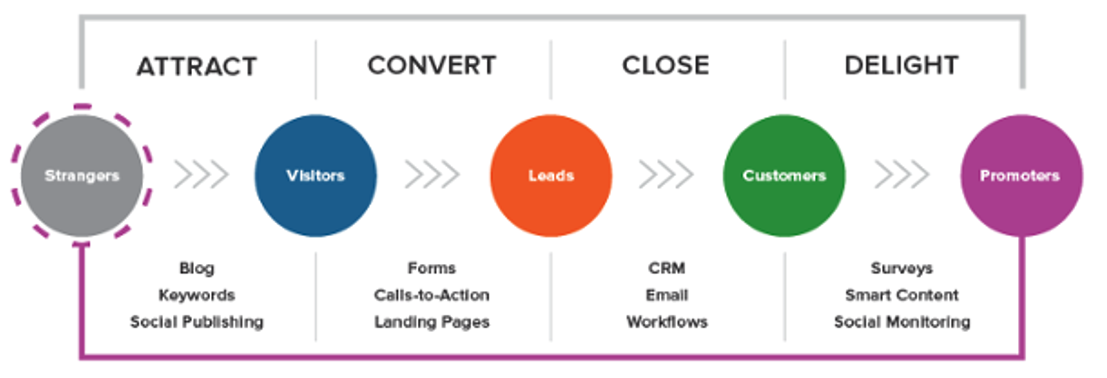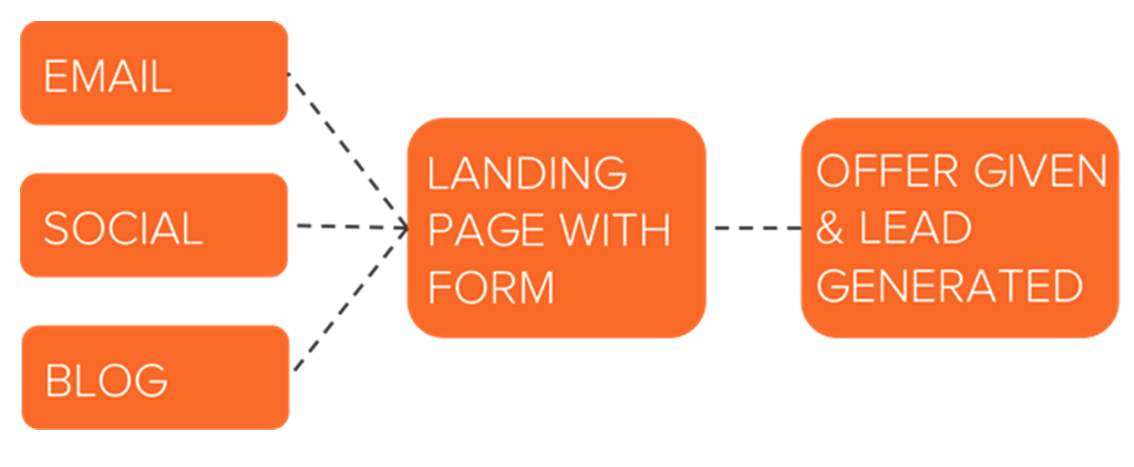Are Trade Shows Back? Read About our Experience with C&M Precision Tech
Tradeshows. Post-COVID meetings. Marketing. Selling. Connecting. Networking
Lead generation is the process of attracting and converting to customers people who have indicated an interest in your company’s products or services.
We’ve all been there. You’re sitting at the dinner table about to dig into the best plate of spaghetti and meatballs you’ve ever seen when the phone rings and the telemarketer on the other end of the line asks to speak with you so he can sell you something.
Frustrating interruptions like the one described can become relics of the past if you use inbound marketing to generate leads instead of doing things the old-fashioned, less efficient, and more expensive way.
In this blog post, we will help you understand the benefits of inbound marketing by:
 A lead is a person who has indicated interest in your company's product or service. Perhaps the individual took an online survey to learn more about how your company may be able to help him or her. Perhaps the person received an email from one of your suppliers that sponsored the survey.
A lead is a person who has indicated interest in your company's product or service. Perhaps the individual took an online survey to learn more about how your company may be able to help him or her. Perhaps the person received an email from one of your suppliers that sponsored the survey.
Regardless of specifics, it is far less intrusive and more relevant to interact with a prospective customer that has shown an interest in what you’re offering than just calling (or mailing or buying ads) to reach people “out of the blue” with no knowledge of whether they care about your products or services.
What’s more, the information you collect from survey responses helps you personalize communications with leads so you can address their challenges or problems immediately and increase the probability that they become your customers.

Lead generation is the process of attracting and converting to customers people who have indicated an interest in your company’s products or services. Examples of lead generators are eNewsletters and targeted mailers, blog posts and other online content such as webinars, as well as in-person events such as tradeshows and conferences.
Communications tools can serve as unique ways to attract people to your business. By giving them enough content that shows your expertise, and that your company has a “human side,” you hope to get them interested in your company to the extent that they eventually warm up to your brand (the feelings you create around your products or services) hear from you so you can get them on the path to becoming customers who buy regularly from you.
Now that you understand how lead generation fits into the entire inbound marketing methodology. As a reminder, inbound attracts customers by creating valuable content and experiences tailored to them. In contrast, outbound marketing interrupts your audience with content they don’t always want. Additionally, inbound marketing forms connections your customers and prospects are looking for and helps them solve problems they already have.
The steps of the inbound marketing process are:
To start generating leads, you can use your various promotional channels to drive traffic to your landing page.
What channels should you use to promote your landing page? Let’s talk about the front-end of lead generation — lead gen marketing.
This chart shows the flow from promotional marketing channels to a generated lead.

There are even more channels you can use to get visitors to become leads.
Content is an excellent way to guide users to a landing page. Typically, you create content to offer visitors useful, free information. You can include CTAs anywhere in your content — inline, bottom-of-post, in the hero image, or on the side panel. The more delighted a visitor is with your content, the more likely he or she is to click your call-to-action and move onto your landing page.
Email is an effective tool for reaching people who are familiar with your brand and already know about your products or services. It’s much easier to ask them to take an action because they’ve previously subscribed to your Email list. Emails tend to be a bit cluttered, so use small amounts of compelling copy (Less is more!) and CTA buttons that make clicking “irresistible.”
When it comes to ads and re-targeting, it’s important to note that the sole purpose of an ad is to get people to take an action. Otherwise, why spend the money? If you want people to convert, be sure that your landing page and offer match exactly what is promised in the ad, and that the action you want users to take is clear.

Blog posts can also be effective for promoting offers by tailoring the piece to your objective. For example, if your offer is for complimentary tool regrinding if one purchases specific quantities of new tooling by a particular date, you can write a blog post, accompanied by a video, about the importance of keeping tooling in top working condition, which would make your CTA highly relevant and easy to click.
Social media platforms such as LinkedIn and Twitter make it easy to guide your followers to act. You can also promote your offerings on your social posts and include a call-to-action in your caption.
Marketers and salespeople alike want to fill their sales funnels — and they want to fill them quickly. Enter: The temptation to buy leads.
Buying leads, as opposed to organically generating them through inbound marketing, is much easier, takes far less time and effort, and is more expensive. But you might be paying for advertising anyway, so why not just buy leads?
First, any leads you've purchased don't know who you are. Typically, they've "opted in" at some other website when signing up for something and didn't opt-in to receiving anything from your company.
 Therefore, the messages you send them are unwanted communication, and sending unwanted messages is intrusive. (Remember the hypothetical disruptive call, described earlier, that you received when you were trying to eat your spaghetti?) That's how people feel when they receive emails and other messages from people they didn't ask to hear from!
Therefore, the messages you send them are unwanted communication, and sending unwanted messages is intrusive. (Remember the hypothetical disruptive call, described earlier, that you received when you were trying to eat your spaghetti?) That's how people feel when they receive emails and other messages from people they didn't ask to hear from!
If the prospect has never been to your website and has never expressed an interest in your products or services, then you’re interrupting them, plain and simple. If they’ve never opted in to receive messages from you, then there’s a high chance they could flag your message as spam, which isn’t good for business. That’s why It’s always better to generate leads organically instead of buying them from a list broker.
 As noted earlier, a lead is a person who has indicated an interest in your company's products or services. A sales lead is generated through information collection, such as a person filling out a form to download an educational piece of content.
As noted earlier, a lead is a person who has indicated an interest in your company's products or services. A sales lead is generated through information collection, such as a person filling out a form to download an educational piece of content.
The pieces of information you should collect are:
Lead scoring is a way to qualify leads quantitatively. Using this technique, leads are assigned a numerical value, or score, to determine where they fall on the scale from “interested” to “ready to buy.” The criteria for these actions are completely up to you, but they must be uniform across your marketing and sales teams so that everyone is using the same scale.
A lead’s score can be based on actions they’ve taken, information they’ve shared, their level of engagement with your brand, or other relevant criteria that your sales team establishes. For example, you may score someone higher if he or she regularly engages with you on social media, or if their demographic information matches one of the personas (job titles) in your target audiences.
You might give a lead a higher score if he or she requested information through a landing page — an action that would signify this person is interested in your products or services.
The higher a lead’s score is, the closer that individual is to becoming a sales-qualified lead (SQL) -- a step away from becoming a customer! The score and criteria are something you may need to tweak along the way until you find the formula that works, but once you do, you’ll transform your lead generation into customer generation.
After you’ve dedicated resources to inbound marketing activities, you're getting web traffic and generating leads. But how are you doing compared to other companies in your industry? How many leads should you be generating?
It's tough to figure out if your lead generation strategy is working if you aren't looking at industry data. HubSpot, a company that provides a marketing automation platform that GrowthHive uses with many of our clients, partnered with Qualtrics to survey more than 900 marketers from different industries across North America and Europe to create a demand generation report with data on website visitors, leads, opportunities, customers, and revenue.
The report revealed that 74% of companies that weren’t exceeding revenue goals didn't know their visitor, lead, MQL, or sales opportunities numbers. Additionally, more than 70% of the companies surveyed that did not achieve their revenue goals generated fewer than 100 leads per month. What’s more, only 5% of the companies surveyed generated more than 2,500 leads per month.
Unsurprisingly, the more revenue a company has, the more leads they generate. The differences are most drastic at the highest and lowest ends of the spectrum: 82% of companies with $250,000 or less in annual revenue report generating fewer than 100 leads per month, whereas only 8% of companies generating $1 billion in annual revenue report generating fewer than 100 leads per month.
HubSpot found that 58% of companies generated 500 leads per month or fewer, and 71% generated 1,000 or fewer. But as we saw previously, the companies having the most success are also the ones generating the most leads.
HubSpot also found that the most successful lead generation teams use a formal system to organize and store leads. Some 46% use Google Docs, 41% use marketing automation software, and 37% use customer relationship management (CRM) software. It is significant to note that Google Drive integrates with both HubSpot Marketing Hub and HubSpot CRM.
If you’re selling in a B2B environment, then LinkedIn and Twitter are the only social platforms you should use, as well as create a YouTube page for posting videos about your capabilities. That’s because the other platforms (e.g., Facebook, TikTok) are B2C-focused and therefore of less relevance to your target audiences.
Since its early days, LinkedIn has been increasing its stake as an advertising platform. When it comes to lead generation, LinkedIn created Lead Gen Forms, which auto-populate with a user’s profile data when he or she clicks a CTA, making it easy for you to capture contact information.
![]() Twitter has Twitter Lead Gen Cards which let you generate leads directly within a tweet without having to leave the site. A user's name, email address, and Twitter username are automatically imported to the card. All the user must do is click "Submit" to become a lead. If you use the HubSpot marketing automation platform, you can connect Twitter Lead Gen Cards to your HubSpot forms.
Twitter has Twitter Lead Gen Cards which let you generate leads directly within a tweet without having to leave the site. A user's name, email address, and Twitter username are automatically imported to the card. All the user must do is click "Submit" to become a lead. If you use the HubSpot marketing automation platform, you can connect Twitter Lead Gen Cards to your HubSpot forms.
Although marketers typically think of social media as best for top-of-the-funnel marketing, it can still be a helpful and low-cost source for lead generation if you use it strategically.
You can start by adding links directly to the landing pages of high-performing offers within your Twitter and LinkedIn posts. To set expectations upfront, It’s important for you to tell visitors that you are sending them to a landing page or Contact page so they immediately understand that you would like their contact information.
The term pay-per-click (PPC) refers to ads on search engine result pages (SERPs). Google gets nearly 6 billion searches a day and 2 trillion searches a year, making it prime real estate for any ad campaign, especially if lead generation is your key objective. The effectiveness of your PPC campaign relies heavily on a seamless user flow, as well as your budget, target keywords, and other factors too numerous to mention in this space.
When you undertake a lead generation campaign, there are a lot of moving parts. It can be difficult to tell which parts of your campaign are working and which ones need some fine-tuning. What exactly goes into a best-in-class lead generation engine? Here are a few tips for building effective lead generation campaigns.
As you saw in our data, the most successful marketing teams use a formal system to organize and store their leads. That's where lead generation tools and lead generation software come into play.
How much do you know about the people visiting your website? Do you know their names or their email addresses? How about which pages they visited, how they're navigating around, and what they do before and after filling out a lead conversion form?
If you don't know the answers to these questions, chances are you're having a hard time connecting with the people who are visiting your site. These questions are ones you should be able to answer -- and you can – with the right lead generation tools.
There are a few different tools and templates to help you create different lead generation assets to use on your website. They include:
Many website visitors are not ready to talk to your sales team or see a demo of your product. Someone at the beginning of the buyer's journey might be interested in an informational piece such as an eBook or guide, whereas someone who's more familiar with your company and farther along on the journey may be most interested in a free trial or demo.
Make sure you're creating offers for each phase and offering CTAs for these offers throughout your site.
It takes time to create valuable content that teaches and nurtures your leads, but if you don't offer anything to visitors who aren't ready to buy, then they may never come back to visit your website. From checklists to templates to free tools, here are 23 content ideas for lead generation to help you get started.
If you want to take personalization a step further — which will help boost your conversion rate — try to use smart CTAs. Smart CTAs detect where a person is in the buyer’s journey, whether he or she is a new visitor, a lead, or a customer, and display CTAs accordingly. Personalized CTAs convert a whopping 42% more visitors than basic calls-to-action.
The highest-converting lead generation campaigns are the ones that deliver on what they promise and create a seamless
transition from ad copy and design to the deliverable itself. Make sure that you’re presenting a consistent message
throughout the process and providing value to everyone who engages with your lead capture tools.
Your lead generation campaign should mirror everything on your website, your blog page, and within the product that you will eventually try to sell. If there are inconsistencies, you will have a difficult time getting your lead to the next lifecycle stage. Therefore, Your campaign should be about developing a new customer instead of merely capturing an email address.
A successful marketing program, including the use of lead scoring, is not possible without input from your sales team. How will you know what qualifies a lead for sales without knowing if your defined sales-qualified leads (SQLs) are solid? Your marketing and sales teams need to be aligned on the definitions and the process of moving a lead from a marketing-qualified lead (MQL) to SQL to a sales opportunity before you even begin to capture leads.
Based on my experience, it is important to prepare for your relationship with the sales team to evolve and to be flexible about how you guide leads through your funnels. As you refine your definitions and other criteria over time, it is essential to make sure you keep everyone involved up-to-date on changing parameters and metrics.
To discuss your inbound marketing experiences, or to explore how GrowthHive can help you meet your strategic business objectives.
Ready to get started? Set up a time to meet with a member of the GrowthHive team.
Tradeshows. Post-COVID meetings. Marketing. Selling. Connecting. Networking
Find meaningful digital alternatives to traditional marketing when options become unavailable. Video conferencing with prospects, webinars vs...
As we reflect on our 6 year anniversary, we explain our journey to current day and what strategies helped us along the way.
Be the first to know about new B2B SaaS Marketing insights to build or refine your marketing function with the tools and knowledge of today’s industry.